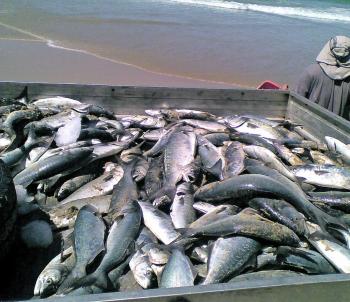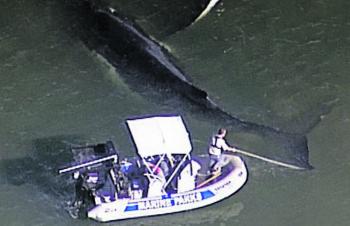The recent issues in Moreton Bay have had me thinking I was in some sort of bad dream.
Once upon a time a federal bureaucrat discovered a monster hiding. He didn’t want to frighten everyone by telling them about it or get offside with the importers under whose house the monster was hiding, so he kept it a big secret until, as you would expect, the monster got out. White spot syndrome virus ravaged the prawn aquaculture ponds on the Logan River and the bureaucrat tried to glamour his way out of it.
That story was scary enough, but it was then followed in close succession by not one, not two, but three toxic chemical spills into the waterways of Moreton Bay. Anyone with a paranoid nature would be seeing all sorts of conspiracy theories given that these three were spread the length of Moreton Bay from Narangba in the north, Brisbane Airport in the centre and Stapylton in the south.
All these issues have rightfully been newsworthy and sadly they have also cost a lot in both financial support to clean up and departmental hours to manage. This has taken the focus from getting the destructive gillnets out of Moreton Bay. Recreational fishers have every reason to have grave concerns in this – a probable election year.
Historically, recreational fishing has had an uphill battle with legislation. In the 1960s and ‘70s, commercial fishing licences and fishery endorsements were handed out left, right and centre. This was during an electoral period that was driven by the primary production focused Country Party. They may have tried to glamour their presentation through changing their name to the National Party and now the LNP, but their archaic beliefs are still front and centre. Like many other ‘flat-Earthers’, they believe that the oceans provide a never-ending source of seafood, no matter how much you net, trawl, trap or suck out of it.
Departmental bureaucrats and their associated fisheries policies have been fashioned by their political leaders over a long period. Over 30 years, the DPI was tasked with ensuring profitable primary industries and to that end fisheries stocks were monitored to ensure that the maximum yield was allowed to be taken each year, as long as there was still some for them to catch the ensuing year. There was no requirement within their protocols to ensure stocks for the recreational catch.
We now have a government that recognizes the high community value placed on recreational fishing in addition to the other intrinsic benefits to the Queensland economy through individual health outcomes, social value outcomes and family relationship outcomes. In addition, as a result of the decimated front line staffing by Campbell Newman, we have less solidarity of focus within the department towards outdated policies and directions.
If you combine a supportive government with some departmental leaders within Fisheries QLD, who are looking to manage the fishery as whole for all sectors and rebalance the playing field to create equity and consciously provide for an ongoing productive fishery, we should be content.
Sadly, the legacies of Joh Bjelke Petersen and Campbell Newman will take a lot more time to recover from. I have been unable to find a single document that speaks favourably about the accuracy of the commercial logbook data collection system. This means that no one can say with any real certainty how much is harvested annually. It has been many years since stock assessments were done that weren’t modelled extrapolations of old data upsized by logbook data.
That means that no one can say for sure how many fish are in the sea or how many are being taken out. This is why all of a sudden, late last year, Fisheries QLD undertook an assessment of the scallop fishery and found it was down to about 6% of what it was in 1977 – 6% and no one noticed! How many other fisheries have been fished down to critical levels without any measures in place to notice?
Back to scary concerns in Moreton Bay, recreational fishers have been trying to ring alarm bells since the ‘70s with respect to the seriously declining recreational catch rates that they believed were indicators of excessive pressure from commercial netting.
In its heyday, the Moreton Bay net fishery was primarily a mullet fishery. When there weren’t enough mullet being caught to maintain catch levels by all the netters in this fishery they transitioned to inshore finfish. We are now seeing some of the netters that have previously been targeting inshore finfish diversify into hardiheads and other baitfish.
This is an alarming trend and there is no funding to measure stock levels and therefore no triggers to be activated. Are our iconic inshore species in the same condition as the scallop fishery and no one knows yet? All governments in the current and foreseeable future will be cash limited. We have recently seen the Queensland Government have to fund emergency activities with respect to white spot and chemical spills.
I implore Minister Byrne and the Queensland Government to consider funding a Moreton Bay net free area under emergency provisions, given that there is a clear and present danger to the stock levels of inshore finfish in Moreton Bay, not to mention the significant and internationally recognized danger to whales, turtles and dugongs by gillnets in Moreton Bay. Leaving it to the next electoral cycle may be too late to save our Moreton Bay Fishery.
Reads: 2404
The Moreton Bay fishery is seriously at risk. If it’s left for much longer without help, it may be too late to save our Moreton Bay Fishery.

No one can say with any real certainty how much is harvested annually.

There is a clear and present danger to the stock levels of inshore finfish in Moreton Bay, not to mention the significant and internationally recognized danger to whales, turtles and dugongs by gillnets in Moreton Bay.




